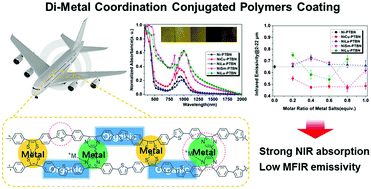Construction of dimetal-containing dithiolene and Schiff base conjugated polymer coating: exploiting metal coordination as a design strategy for improving infrared stealth properties†
Abstract
In order to reduce mid–far-infrared emissivity while enhancing the near-infrared absorption properties of polymer coating systems, bimetal coordination conjugated polymer coatings are fabricated via baking organic linkers (oligomer-containing nickel bis(dithiolene) moiety, 3,3′-diaminobenzidine, metal salts) in the presence of co-reagents (dimethylacetamide and acetic acid). By varying the reaction temperature, feed ratios and quantity of metals, the degree of cross-linking of the metallopolymer (MOP) coating could be precisely controlled with an excellent film-forming property. The structures were confirmed by FT-IR, XPS and ICP. The results indicate a metal (Cu, La, Sm and Lu) coordination effect with conjugated polymer main chains being formed together with nickel-bis(dithiolene) structures. Due to the high electron deficiency ability of the nickel bis(dithiolene) moiety, all MOP coatings show electron transport behaviors without hole transport properties, except for NiCu-PTBN and NiSm-PTBN. Doping of CuBr2 and Sm(OAc)3·6H2O with a metal coordination effect under carefully controlled conditions gives rise to NiCu-PTBN and NiSm-PTBN coatings with hole mobilities up to 2.9 × 10−4 cm2 V−1 s−1 and 2.5 × 10−4 cm2 V−1 s−1, respectively. Stealth performance experiments show that the absorption wavelength of the MOP coating is 750–1200 nm in the near-infrared range, which indicates its excellent near-infrared shield properties. The mid–far-infrared emissivity (2–22 μm) of the nickel/samarium-containing coating could decrease to 0.47 ± 0.03. Overall, these results raise the possibility that an MOP coating is a prospective candidate for infrared stealth applications.



 Please wait while we load your content...
Please wait while we load your content...